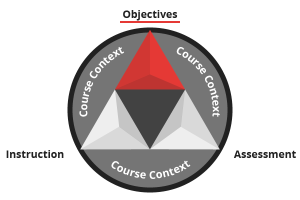The Course Design Triangle

Course design is especially critical for online courses because you have to produce your course materials in advance. Once the course is live and students are enrolled, it’s much harder to adjust materials on the fly. However, if you spend time up front thoughtfully and systematically designing your course, it can prevent a wealth of time-consuming problems later on.
 Of all the considerations that go into the development of your course, nothing is more important than making sure your course elements align. The course design triangle is a simple but powerful model to help you do just that. Using the principles of backward design, this model begins with learning goals in mind and structures the course to serve those goals.
Of all the considerations that go into the development of your course, nothing is more important than making sure your course elements align. The course design triangle is a simple but powerful model to help you do just that. Using the principles of backward design, this model begins with learning goals in mind and structures the course to serve those goals.
The course design triangle has three principal components: objectives, assessments, and instruction. To achieve a coherent learning experience, all three course components must closely align with one another and also consider the course context. In this article, we’ll discuss each of these elements, including the roles they play in your course and how to ensure that they’re aligned.
Course Context
The first step in designing a course is to find out as much as you can about the context in which you’ll be teaching. Who are your students? How big is the class? How many credits does the course carry? What courses come before and after it in the curriculum? The answers to these kinds of questions will influence all other aspects of course design and will help you do the following:
- Determine the appropriate learning objectives for your course, given how it fits into the rest of the curriculum.
- Determine the right level of challenge, given your students’ backgrounds and prior knowledge.
- Consider how to motivate and engage your students effectively, given what you can predict about their academic, professional, and personal goals.
- Decide what kind of assessment is manageable, given your class’s size and the resources you have available for grading and feedback.
By determining your course context, you’re better informed to create learning objectives, assessments, and instructional materials that meet your students’ needs.
Course Components
After you identify relevant information about your course context, it’s time to consider the three key elements of the course design triangle:
 |
Learning objectives: The statements that describe your goals for student learning. Learning objectives are the bedrock of course design and shape all other components. |
 |
Assessments: The methods and tasks (e.g., projects, presentations, exams, activities) you’ll use to monitor students’ progress toward your objectives. |
 |
Instruction: The day-to-day activities (e.g., readings, discussions, lectures, group work, case studies) you’ll use to help students reach the objectives you have set. |
Alignment
The three components of the course design triangle don’t work in isolation. Learning objectives, assessments, and instruction must work together so that the instruction helps students achieve the course objectives and the assessments accurately gauge students’ progress toward those objectives. When the components are out of alignment (i.e., when your teaching methods don’t support your goals or when you teach one thing but assess another), learning and student motivation can suffer.
To make sure your components are aligned, check the verbs in your objectives, assessments, and instruction. If they don’t match, that often indicates that the skills you’ve prioritized and those you’re reinforcing or evaluating are not the same. For example, there’s misalignment if you want your students to analyze historical documents but your exams only ask them to recall names and dates by answering multiple-choice questions. Similarly, if you want students to evaluate research articles but you only give them practice summarizing research articles, that too is misalignment.
There are many ways to fix alignment problems. If you have a particularly rich and interesting assignment that doesn’t align with your objectives, maybe you need to reevaluate and tweak your objectives. Or if you find that your instruction doesn’t give students the practice they need to succeed on assessments, you may need to add a few check-for-understanding quizzes or substitute a short writing assignment for a lecture.
Conclusion
A course’s worth of new content can be intimidating for students to approach and try to retain. However, when all your course’s components align and support one another within the course’s context, the course’s design can help students focus on the most important information. The course design triangle can help you design your course so that every component targets your objectives and all your instructional resources support students’ success in your course.
